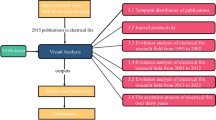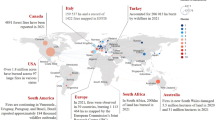Abstract
The topic of tunnel fire attracted considerable attention in past two decades. The popularity of this topic is mainly attributed to the widespread construction of long-span tunnels and their incident fire safety issues, as well as the frequent occurrence of catastrophic tunnel fires. To date, a number of research papers have been published focusing on specific aspects of tunnel fires such as fire dynamics, smoke extraction, fire suppression system, personnel evacuation, fire risk evaluation, and some others with broader areas of focus. In this work, a thorough bibliometric and network analysis is conducted on the basis of peer-reviewed publications on tunnel fires, seeking to provide insights in this topic. A total of 519 research articles are obtained from the Web of Science Core Collection database. It is identified that the most prolific journal is Tunnelling and Underground Space Technology, with 121 papers, accounting for 23.3% of the total. England is the most influential region with the highest citations per document, while China is the most prolific country with nearly a half of the total, where the University of Science and Technology of China is the primary contributor. The visualization and cluster analysis of research topics indicate that the currently bursting topics mainly concentrate on the smoke thermodynamics and smoke extraction based on model-scale tests. The reference analysis and co-citation network also confirm the findings.









Similar content being viewed by others
References
Alpert RL (2016) Ceiling jet flows. In: Hurley MJ, Gottuk D, Hall JR et al (eds) SFPE handbook of fire protection engineering. Springer, New York, pp 429–454
Atkinson GT, Wu Y (1996) Smoke control in sloping tunnels. Fire Saf J 27:335–341
Barbato L, Cascetta F, Musto M, Rotondo G (2014) Fire safety investigation for road tunnel ventilation systems—an overview. Tunn Undergr Space Technol 43:253–265
Beard AN, Carvel R (2012) Handbook of tunnel fire safety, 2nd edn. ICE Publishing
Besserre R, Delort P (1997) Recent studies prove that the main cause of death during urban fires is poisoning by smoke. Urgences Medicales 16:77–80
Byrne E, Georgieva K, Carvel R (2018) Fires in ducts: a review of the early research which underpins modern tunnel fire safety engineering. Tunn Undergr Space Technol 81:306–314
Carvel RO (2004) Fire size in tunnels. Heriot-watt University, Riccarton, New Zealand
Carvel RO, Beard AN, Jowitt PW (2001a) The influence of longitudinal ventilation systems on fires in tunnels. Tunn Undergr Space Technol 16:3–21
Carvel RO, Beard AN, Jowitt PW, Drysdale DD (2001b) Variation of heat release rate with forced longitudinal ventilation for vehicle fires in tunnels. Fire Saf J 36:569–596
Carvel RO, Beard AN, Jowitt PW, Drysdale DD (2004) The influence of tunnel geometry and ventilation on the heat release rate of a fire. Fire Technol 40:5–26
Cashdollar KL, Singer JM, Lee CK, Litton CD (1981) Smoke characteristics of coal-lined tunnel fires. Fire Mater 5:47–51
Chen C (2006) CiteSpace II: detecting and visualizing emerging trends and transient patterns in scientific literature. J Am Soc Inform Sci Technol 57:359–377
Chen C, Ibekwe-SanJuan F, Hou J (2010) The structure and dynamics of cocitation clusters: A multiple-perspective cocitation analysis. J Am Soc Inform Sci Technol 61:1386–1409
Chen LF, Hu LH, Tang W, Yi L (2013) Studies on buoyancy driven two-directional smoke flow layering length with combination of point extraction and longitudinal ventilation in tunnel fires. Fire Saf J 59:94–101
Danvila-del-Valle I, Estévez-Mendoza C, Lara FJ (2019) Human resources training: a bibliometric analysis. J Bus Res 101:627–636
Dunning T (1993) Accurate methods for the statistics of surprise and coincidence. Comput Linguist 19:61–74
Dzikowski P (2018) A bibliometric analysis of born global firms. J Bus Res 85:281–294
Fan C, Zhang L, Jiao S, Yang Z, Li M, Liu X (2018) Smoke spread characteristics inside a tunnel with natural ventilation under a strong environmental wind. Tunn Undergr Space Technol 82:99–110
Fan CG, Ji J, Gao ZH, Han JY, Sun JH (2013a) Experimental study of air entrainment mode with natural ventilation using shafts in road tunnel fires. Int J Heat Mass Transf 56:750–757
Fan CG, Ji J, Gao ZH, Sun JH (2013b) Experimental study on transverse smoke temperature distribution in road tunnel fires. Tunn Undergr Space Technol 37:89–95
Fan CG, Tang F (2017) Flame interaction and burning characteristics of abreast liquid fuel fires with cross wind. Exp Thermal Fluid Sci 82:160–165
Grant GB, Drysdale DD (1997) Estimating heat release rates from large-scale tunnel fires. Fire Saf Sci 5:1213–1224
Hu LH, Chen LF, Wu L, Li YF, Zhang JY, Meng N (2013a) An experimental investigation and correlation on buoyant gas temperature below ceiling in a slopping tunnel fire. Appl Therm Eng 51:246–254
Hu LH, Huo R, Li YZ, Wang HB, Chow WK (2005) Full-scale burning tests on studying smoke temperature and velocity along a corridor. Tunn Undergr Space Technol 20:223–229
Hu LH, Huo R, Wang HB, Li YZ, Yang RX (2007) Experimental studies on fire-induced buoyant smoke temperature distribution along tunnel ceiling. Build Environ 42:3905–3915
Hu LH, Tanga W, Chen LF, Yi L (2013b) A non-dimensional global correlation of maximum gas temperature beneath ceiling with different blockage-fire distance in a longitudinal ventilated tunnel. Appl Therm Eng 56:77–82
Huang Y, Li Y, Li J, Li J, Wu K, Zhu K, Li H (2019) Experimental investigation on maximum gas temperature beneath the ceiling in a branched tunnel fire. Int J Therm Sci 145:105997
Ingason H (2008) State of the art of tunnel fire research. Fire Saf Sci 9:33–48
Ingason H, Li YZ (2010) Model scale tunnel fire tests with longitudinal ventilation. Fire Saf J 45:371–384
Ingason H, Li YZ, Lönnermark A (2014) Tunnel fire dynamics. Springer, Berlin
Ingason H, Lönnermark A (2005) Heat release rates from heavy goods vehicle trailer fires in tunnels. Fire Saf J 40:646–668
Inokuma A, Iwai K, Ishidaka T, Ushigome T, Mizutani T (1993) State of the road tunnel equipment technology in Japan: ventilation, lighting, safety equipment. Technical note 61
Ji J, Fan CG, Gao ZH, Sun JH (2014) Effects of vertical shaft geometry on natural ventilation in urban road tunnel fires. J Civ Eng Manag 20:466–476
Ji J, Fan CG, Zhong W, Shen XB, Sun JH (2012a) Experimental investigation on influence of different transverse fire locations on maximum smoke temperature under the tunnel ceiling. Int J Heat Mass Transf 55:4817–4826
Ji J, Gao ZH, Fan CG, Zhong W, Sun JH (2012b) A study of the effect of plug-holing and boundary layer separation on natural ventilation with vertical shaft in urban road tunnel fires. Int J Heat Mass Transf 55:6032–6041
Ji J, Guo F, Gao Z, Zhu J (2018) Effects of ambient pressure on transport characteristics of thermal-driven smoke flow in a tunnel. Int J Therm Sci 125:210–217
Ji J, Wan HX, Li KY, Han JY, Sun JH (2015) A numerical study on upstream maximum temperature in inclined urban road tunnel fires. Int J Heat Mass Transf 88:516–526
Ji J, Zhong W, Li KY, Shen XB, Zhang Y, Huo R (2011) A simplified calculation method on maximum smoke temperature under the ceiling in subway station fires. Tunn Undergr Space Technol 26:490–496
Kashef A, Yuan ZY, Lei B (2013) Ceiling temperature distribution and smoke diffusion in tunnel fires with natural ventilation. Fire Saf J 62:249–255
Lacroix D (2001) The Mont Blanc tunnel fire. What happened and what has been learned, proceedings of the fourth international conference on safety in road and rail tunnels, held Madrid, Spain, 2–6 April 2001
Leitner A (2001) The fire catastrophe in the Tauern Tunnel: experience and conclusions for the Austrian guidelines. Tunn Undergr Space Technol 16:217–223
Li JSM, Chow WK (2003) Numerical studies on performance evaluation of tunnel ventilation safety systems. Tunn Undergr Space Technol 18:435–452
Li W, Zhao Y, Wang Q, Zhou J (2019) Twenty years of entropy research: a bibliometric overview. Entropy 21:694
Li YZ, Lei B, Ingason H (2010) Study of critical velocity and backlayering length in longitudinally ventilated tunnel fires. Fire Saf J 45:361–370
Li YZ, Lei B, Ingason H (2011) The maximum temperature of buoyancy-driven smoke flow beneath the ceiling in tunnel fires. Fire Saf J 46:204–210
Lönnermark A, Ingason H (2005) Gas temperatures in heavy goods vehicle fires in tunnels. Fire Saf J 40:506–527
Marshakova-Shaikevich I (1973) System of documentation connections based on references. Nauchno Tekhnicheskaya Informatsiya Seriya 2:3–8
McGrattan K, McDermott R, Hostikka S, Floyd J (2010) Fire dynamics simulator (version 5) user’s guide. National Institute of Standards and Technology, Gaithersburg, MD. NIST Special Publication, pp 1019–1015
Ramos-Rodríguez AR, Ruíz-Navarro J (2004) Changes in the intellectual structure of strategic management research: a bibliometric study of the Strategic Management Journal, 1980–2000. Strateg Manag J 25:981–1004
Rodrigues SP, van Eck NJ, Waltman L, Jansen FW (2014) Mapping patient safety: a large-scale literature review using bibliometric visualisation techniques. BMJ Open 4:8
Small H (1973) Co-citation in the scientific literature: a new measure of the relationship between two documents. J Am Soc Inform Sci 24:265–269
Tang W, Hu LH, Chen LF (2013) Effect of blockage-fire distance on buoyancy driven back-layering length and critical velocity in a tunnel: An experimental investigation and global correlations. Appl Therm Eng 60:7–14
van Eck NJ, Waltman L, Noyons ECM, Buter RK (2010) Automatic term identification for bibliometric mapping. Scientometrics 82:581–596
Van Nunen K, Li J, Reniers G, Koen P (2018) Bibliometric analysis of safety culture research. Saf Sci 108:248–258
Vauquelin O, Megret O (2002) Smoke extraction experiments in case of fire in a tunnel. Fire Saf J 37:525–533
Waltman L, van Eck NJ, Noyons ECM (2010) A unified approach to mapping and clustering of bibliometric networks. J Informetr 4:629–635
Wan HX, Gao ZH, Han JY, Ji J, Ye MJ, Zhang YM (2019) A numerical study on smoke back-layering length and inlet air velocity of fires in an inclined tunnel under natural ventilation with a vertical shaft. Int J Therm Sci 138:293–303
Wang KH, Chen JM, Wang ZK, Gao DL, Wang GY, Lin P (2019) An experimental study on self-extinction of tunnel fire under natural ventilation condition. Tunn Undergr Space Technol 84:177–188
Wang Y, Jiang J, Zhu D (2009) Full-scale experiment research and theoretical study for fires in tunnels with roof openings. Fire Saf J 44:339–348
Yao YZ, Li YZ, Ingason H, Cheng XD (2019) Numerical study on overall smoke control using naturally ventilated shafts during fires in a road tunnel. Int J Therm Sci 140:491–504
Zhang S, Wang J, He K, Yao Y, Peng M (2019) Study on the smoke back-layering and critical ventilation in the road tunnel fire at high altitude. Fire Mater 43:422–429
Zheng T, Wang J, Wang Q, Nie C, Shi Z, Wang X, Gao Z (2016) A bibliometric analysis of micro/nano-bubble related research: current trends, present application, and future prospects. Scientometrics 109:53–71
Zhou T, Liu J, Chen Q, Xiao C, Jian W (2017) Characteristics of smoke movement with forced ventilation by movable fan in a tunnel fire. Tunn Undergr Space Technol 64:95–102
Zhou TN, Wang XH, He JJ, Chen QP, Wang J (2019) The effect of forced ventilation by using two movable fans on thermal smoke movement in a tunnel fire. J Wind Eng Ind Aerodyn 184:321–328
Acknowledgements
The funding was provide by National Natural Science Foundation of China (Grant Nos. 51909152, 51874042, 51904185) and Shanghai Sailing Program (Grant No. 18YF1409600).
Author information
Authors and Affiliations
Corresponding author
Additional information
Publisher's Note
Springer Nature remains neutral with regard to jurisdictional claims in published maps and institutional affiliations.
Rights and permissions
About this article
Cite this article
Li, J., Liu, J. Science Mapping of Tunnel Fires: A Scientometric Analysis-Based Study. Fire Technol 56, 2111–2135 (2020). https://doi.org/10.1007/s10694-020-00969-z
Received:
Accepted:
Published:
Issue Date:
DOI: https://doi.org/10.1007/s10694-020-00969-z




